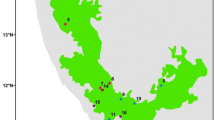Abstract
The Mentawai snub-nosed langur (Simias concolor) and the Mentawai langur (Presbytis potenziani) were observed on Siberut Island, off the west coast of Sumatra, for about 20 months during 1974–1978. The Mentawai snub-nosed langur was organized into monogamous groups in the major study area, but formed larger polygamous groups in some limited areas. Where larger polygamous groups were observed, the snub-nosed langur was found at an extremely high density. On the other hand, in the area where monogamous groups were observed, they occurred at a low density. Such differences in social organization are discussed in relation to excessive hunting by the natives. Mentawai langurs were found in small monogamous groups throughout the island, a condition never observed in any other known Old World monkeys.
Similar content being viewed by others
References
Bakar, A., 1979. Morphological study of mandibles of primates living on Siberut Island, Indonesia. In:A Comparative Sociological Study on Coloboid Monkeys in Tropical Asia. Report of Overseas Scientific Survey in 1976–1978. Primate Research Inst., Kyoto Univ., Inuyama, pp. 95–141.
Baldwin, L. A., M. Kavanagh &G. Teleki, 1975. Field research on langurs and proboscis monkeys: an historical, geographical and bibliographical listing.Primates, 16: 351–363.
Carpenter, C. R., 1942. Characteristics of social behavior in nonhuman primates.New York Acad. Sci., 4(8): 248–258.
Chasen, F. N., 1940. A handlist of Malaysian mammals.Bull. Raffles Mus., Singapore, 15: 1–209.
----, &C. B. Kloss, 1927. Spolia Mentawiensia. Mammals.Proc. Zool. Soc., Lond., pp. 797–840.
Crook, J. H., 1970. The socio-ecology of primates. In:Social Behavior in Birds and Mammals,J. H. Crook (ed.), Academic press, London, pp. 103–166.
———— &J. S. Gartlan, 1966. Evolution of primate societies.Nature, 210: 1200–1203.
Darby, H. C., 1944.Netherlands East Indies, Vol. 1. Great Britain Naval Intelligence Geographical Handbook, No. B. R. 518., London.
DeVore, I., 1963. A comparison of the ecology and behavior of monkeys and apes. In:Classification and Human Evolution,S. L. Washburn (ed.), Viking Fund Pub. No. 37, Wenner-Gren Foundation, New York, pp. 301–319.
Directorate of Forest Planning, 1973. Survey report on the Siberut Barat Daya forest complex, Province of West Sumatra. Report, No. 434, Jakarta.
Ehara, A., 1979. On the morphological features of the Nasal bones ofSimias concolor. In:A Comparative Sociological Study on Coloboid Monkeys in Tropical Asia. Report of Overseas Scientific Survey in 1976–1978. Primate Research Inst., Kyoto Univ., Inuyama, pp. 93–94.
Eisenberg, J. F., N. A. Muckenhirn &R. Rudran, 1972. The relation between ecology and social structure in primates.Science, 176: 863–874.
Fooden, J., 1975.Taxonomy and Evolution of Liontail and Pigtail Macaques (Primates: Cercopithecidae). Fieldiana Zoology, 67.
Groves, C. P., 1970. The forgotten leaf-eaters and the phylogeny of the Colobinae. In:Old World Monkeys,J. R. Napier &P. H. Napier (eds.), Academic Press, New York, pp. 555–587.
Itani, J., 1972. A preliminary essay on the relationship between social organization and incest avoidance in nonhuman primates. In:Primate Socialization,F. E. Poirier (ed.), Random House, New York, pp. 165–171.
Kawamura, S., 1979. Social life ofPresbytis melalophos in Sumatra. In:A Comparative Sociological Study on Coloboid Monkeys in Tropical Asia. Report of Overseas Scientific Survey in 1976–1978. Primate Research Inst., Kyoto Univ., Inuyama, pp. 1–13.
Kummer, H., 1971.Primate Societies: Group Techniques of Ecological Adaptation. Aldine-Atherton, Chicago.
Loeb, E. B., 1935.Sumatra: Its History and People. Institute für Volkerkunde der Universität, Wien.
Marler, P., 1968. Aggression and dispersal: two functions in primate communication. In:Primates. Studies in Adaptation and Variability,P. C. Jay (ed.), Holt, Rinehart & Winston, New York, pp. 420–438.
Medway, L., 1970. The monkeys of Sundaland: ecology and systematics of the cercopithecids of a humid equatorial environment. In:Old World Monkeys,J. R. Napier &P. H. Napier (eds.), Academic Press, New York, pp. 513–553.
Miller, J.S., Jr., 1903. Seventy new Malayan mammals.Smithsonian Misc. Coll., 45: 1–73.
Poirier, F. E., 1974. Colobinae aggression: a review. In:Primate Aggression, Territoriality and Xenophobia,R. L. Holloway (ed.), Academic Press, New York, pp. 123–157.
Richards, P. W., 1952.The Tropical Rain Forest: An Ecological Study. Cambridge Univ. Press, London.
Ruhiyat, Y., 1979. Some socio-behavioral aspects ofPresbytis aygula in Telaga Patengan, West Java. In:A Comparative Sociological Study on Coloboid Monkeys in Tropical Asia. Report of Overseas Scientific Survey in 1976–1978. Primate Research Inst., Kyoto Univ., Inuyama, pp. 31–77.
Schefold, R., 1970. Divination in Mentawai.Tropical Man, 3: 1–85.
Schultz, A. H., 1933. Observations on the growth, classification and evolutionary specialization of gibbons and siamangs.Human Biol., 5: 212–255, 385–428.
Scott, K., Jr. &C. J. Selsor, 1961. Observations of the maroon leaf monkey in North Borneo.Mammalia, 25: 184–189.
Tilson, L. T., 1976. Infant coloration and taxonomic affinity of the Mentawai Island leaf monkey,Presbytis potenziani. J. Mamm., 57: 766–769.
————, 1977. Social organization of simakobu monkeys (Nasalis concolor) in Siberut Island, Indonesia.J. Mamm., 58: 202–212.
———— &R. R. Tenaza, 1976. Monogamy and duetting in an Old World monkey.Nature, 263: 320–321.
Washburn, S. L., 1944. The genera of Malaysian langurs.J. Mamm., 25: 289–294.
Whitten, A. J., 1979. Monogamy in Mentawai colobinaes.Abstract of 7th Congr. Int. Primatol. Soc., Bangalore, India, pp. 140.
Wilson, C. C. &W. L. Wilson, 1977. Behavioral and morphological variation among primate population in Sumatra.Yearb. Phys. Anthropol., 20: 207–233.
Author information
Authors and Affiliations
About this article
Cite this article
Watanabe, K. Variations in group composition and population density of the two sympatric Mentawaian leaf-monkeys. Primates 22, 145–160 (1981). https://doi.org/10.1007/BF02382606
Received:
Accepted:
Issue Date:
DOI: https://doi.org/10.1007/BF02382606




